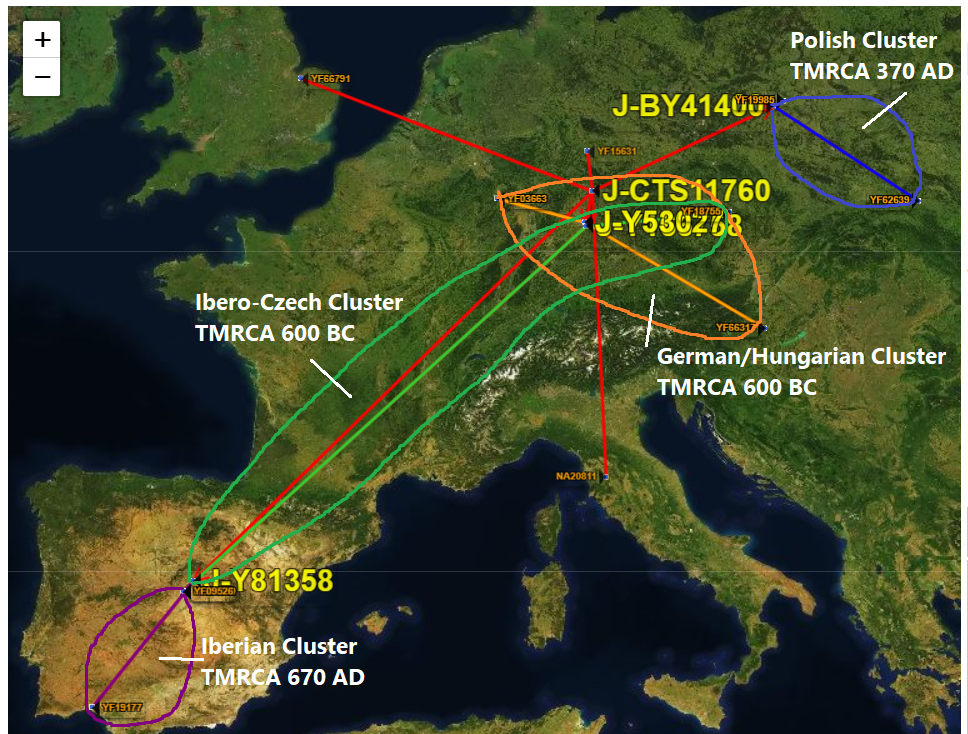The recent find of a J-Z631 buried in a necropolis near Rome initially produced a complication to the theory that child J-Z1043, who was most likely the son or grandson of J-Z631, was a Celt. However an analysis of the ancient "Roman's" autosomal DNA revealed some signature characteristic of Western Europe - which could have come from either or both parents.
J-Z1043, with most of its child lineages found north of the Alps, has in recent months been found to contain Balkan samples in lineages previously restricted to NW Europeans.
While I think we need to keep evaluating new and existing evidence with an open mind, I think a Celtic origin for J-Z1043 is more likely based on:
- The timing of the diversification of Z1043 corresponding with the rise of the Hallstatt Culture (Ha C, 800 - 620 BC) in Central Europe
- The lack of Italian/Balkan only lineages
- The presence of exclusively Central and Eastern European lineages that predate a Roman mediated migration (German/Polish/Hungarian J-Y29721, German/Hungarian J-Y53027, Polish J-BY41400)
J-Z631, J-Z1043 and most of its lineages expanded 800 BC during the Hallstatt C phase. During this phase the Hallstatt Culture is classified as Western or Eastern Hallstatt, the determination based on archaeological finds.
The western Hallstatt zone comprised the area between NE France, southern Germany, western Austria, northern Switzerland and Bohemia. More peripheral to this zone were parts of Iberia and Central/Northern Italy.
Trade, cultural diffusion, and some population movements spread the Hallstatt cultural complex (western form) into Britain, and Ireland.
The eastern Hallstatt zone comprised eastern Austria, Moravia, SW Slovakia, W Hungary, E Slovenia, N Croatia, North/Central Serbia and parts of SW Poland. [source for above 3 paragraphs, Wikipedia Hallstatt]

Interestingly J-CTS11760 has modern presence covering almost the entire extent of the Western and Eastern Hallstatt zones.
Its exclusively Polish lineage J-BY41400 has most recent common ancestor who lived about 370 AD. Poland is the periphery of a much more western distribution of CTS11760. So this precludes a Slavic origin which would have been much further east. The time of 370 AD might match the movements of certain migration era Germanic tribes into Poland but the direction would have been from Scandinavia, which seems an unlikely origin based on samples so far obtained. The earliest Germanic incursions into Poland from the Continent would not have occurred until after 1000 AD and the two men on YFull trace descent to areas of minimal or zero German occupation/interference, Greater Poland and Subcarpathian Voivodeships.
The simplest explanation not fraught with inconsistencies is that the ancestors of J-BY41400 were already living there when the Slavs entered the area, because they were the descendants of Celts that had migrated there when the areas were linked to the Hallstatt or La Tene cultural horizons.
Recently discovered J-Y53027 is another lineage of J-CTS11760 that strengthens the Celtic origin theory. It formed 600 BC and has so far been found only in Rheinland Pfalz, Austria and a town on the Austrian/Hungarian border. Based on this relatively tight distribution, it makes sense that the ancestor spent his whole life in Central Europe in 600 BC.
J-Y166758 is a lineage of J-CTS11760 with a wide distribution, consisting of two samples that trace descent to Spain and Czechia. Although the distribution is wide, the fact that one sample is from the Hallstatt core area and the other is from a periphery Hallstatt zone and that the MRCA lived 600 BC suggests a migration from the core Hallstatt zone to Iberia, given the overall geographic context of J-CTS11760.
The two men who form Iberian J-Y81358 represent a common Iberian ancestor who lived 670 AD. This is not such an ironclad case supporting the Celtic theory, though it does not contradict it. If more men from this lineage are found, whose NGS/WGS tests push an Iberian MRCA back to before the Roman presence in Iberia, then this would further strengthen a Celtic origin vis-a-vis a Roman one.
We need to keep looking at the evidence with an open mind. At present I think a Celtic origin for J-Z1043 presents the least inconsistencies. If the theory is correct, the distribution of J-Z1043 in the Balkans and Eastern Europe, while scattered and limited, may be the genetic footprint of otherwise only historically or archaeologically attested Celtic mass migrations into Eastern Europe.